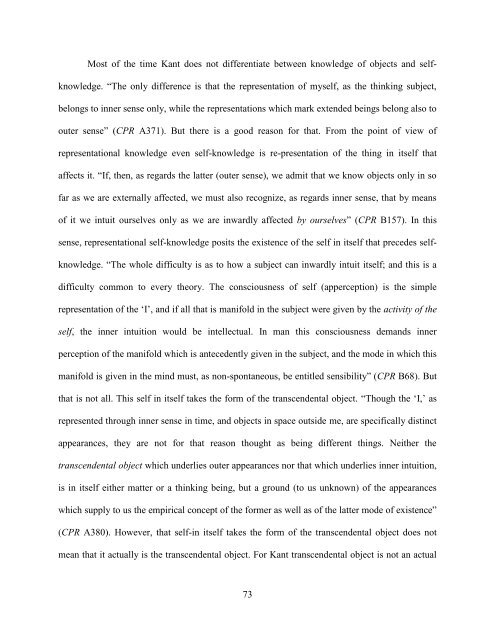stankovic, sasa thesis.pdf - Atrium - University of Guelph
stankovic, sasa thesis.pdf - Atrium - University of Guelph
stankovic, sasa thesis.pdf - Atrium - University of Guelph
You also want an ePaper? Increase the reach of your titles
YUMPU automatically turns print PDFs into web optimized ePapers that Google loves.
Most <strong>of</strong> the time Kant does not differentiate between knowledge <strong>of</strong> objects and self-<br />
knowledge. “The only difference is that the representation <strong>of</strong> myself, as the thinking subject,<br />
belongs to inner sense only, while the representations which mark extended beings belong also to<br />
outer sense” (CPR A371). But there is a good reason for that. From the point <strong>of</strong> view <strong>of</strong><br />
representational knowledge even self-knowledge is re-presentation <strong>of</strong> the thing in itself that<br />
affects it. “If, then, as regards the latter (outer sense), we admit that we know objects only in so<br />
far as we are externally affected, we must also recognize, as regards inner sense, that by means<br />
<strong>of</strong> it we intuit ourselves only as we are inwardly affected by ourselves” (CPR B157). In this<br />
sense, representational self-knowledge posits the existence <strong>of</strong> the self in itself that precedes self-<br />
knowledge. “The whole difficulty is as to how a subject can inwardly intuit itself; and this is a<br />
difficulty common to every theory. The consciousness <strong>of</strong> self (apperception) is the simple<br />
representation <strong>of</strong> the ‘I’, and if all that is manifold in the subject were given by the activity <strong>of</strong> the<br />
self, the inner intuition would be intellectual. In man this consciousness demands inner<br />
perception <strong>of</strong> the manifold which is antecedently given in the subject, and the mode in which this<br />
manifold is given in the mind must, as non-spontaneous, be entitled sensibility” (CPR B68). But<br />
that is not all. This self in itself takes the form <strong>of</strong> the transcendental object. “Though the ‘I,’ as<br />
represented through inner sense in time, and objects in space outside me, are specifically distinct<br />
appearances, they are not for that reason thought as being different things. Neither the<br />
transcendental object which underlies outer appearances nor that which underlies inner intuition,<br />
is in itself either matter or a thinking being, but a ground (to us unknown) <strong>of</strong> the appearances<br />
which supply to us the empirical concept <strong>of</strong> the former as well as <strong>of</strong> the latter mode <strong>of</strong> existence”<br />
(CPR A380). However, that self-in itself takes the form <strong>of</strong> the transcendental object does not<br />
mean that it actually is the transcendental object. For Kant transcendental object is not an actual<br />
73

















